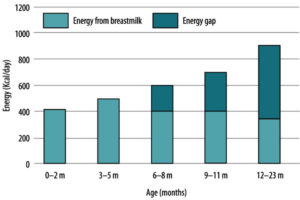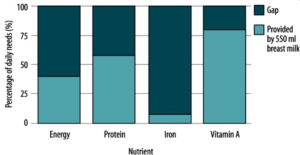
Table of Contents
What is Complementary Feeding?
- Complementary feeding is the food that is given in addition to the breastfeeding to children 6-59 months of age.
- Complementary feeding simply means ‘diet of 6-59 months age children given in addition to breastfeeding‘.
- The term ‘complementary’ refers to “in addition to breastfeeding“
- The word “complementary” is crucial; these first foods work in addition to breast milk, not as a substitute.
- The goal of complementary feeding is that the foods introduced to a child should complement breast milk, not replace it.
- It is a process that starts when breast milk alone is no longer sufficient to fulfill the nutritional requirement of a child.
- During the first six months of life, breastfeeding offers the best nutrition. It gets harder for breastfed infants to get all the nutrients they need from human milk after 6 months of age.
- An infant’s diet must be progressively broadened to include complementary “family foods” in order to ensure that they receive enough energy and nutrients.
- The term “complementary feeding” refers to the process that begins when breast milk or a breast milk substitute by themselves are no longer adequate to fulfill the nutritional needs of infants and additional foods and liquids are consequently required, in addition to breast milk or a breast milk substitute.
- The quality of children’s nutrition is more critical before the age of two than at any other stage in life.
- A child’s growth can be permanently harmed by a lack of nutrition during this age.
Key Facts
- The complementary feeding phase, from 6 to 24 months of age, is a highly critical time since many infants begin to suffer from malnutrition at this time.
- This has a substantial impact on the high prevalence of malnutrition in children under the age of five.
- According to the World Health Organization (WHO), two out of every five children in low-income countries are stunted.
- Worldwide, 1 in 3 children under 5 are underweight and over half do not get a diverse diet that includes fruit, vegetables, eggs, dairy, fish, and meat throughout the complementary feeding stage (6 – 23 months).
- In most countries, less than half of infants and young children 6-23 months of age meet the dietary diversity and feeding frequency that are appropriate for their age. Complementary foods that are introduced in a timely manner, nutritionally adequate, safe, and properly fed together with continued breastfeeding during the first 2 years of a child’s life can save over 820,000 children’s lives every year.
- According to data, nutrition-related causes account for 45% of all under-five-year-old mortality worldwide, with the majority of these deaths occurring in the first year of life.
- Out of all the children under 5 in the world, 149 million were stunted, 45 million were wasting, and 38.9 million were overweight or obese in 2020.
Guiding Principles of Complementary Feeding
1. Duration of exclusive breastfeeding and age at which complementary foods are introduced
- From birth to six months, breastfeed exclusively.
- At six months (after 180 days), introduce complementary meals while still breastfeeding.
2. Continue breastfeeding
- Breastfeed child frequently and whenever necessary until they are two years old or older.
3. Practice responsive feeding
Apply psycho-social care ideas to responsive feeding.
- Infants should be fed directly, and older children should be helped when they feed themselves, paying attention to their hunger and satiety signs.
- Feed children gently and calmly, encouraging them to eat, but never forcing them.
- If children are picky eaters, try experimenting with different food pairings, tastes, textures, and encouraging techniques.
- Reduce distractions during food if the child is easily distracted.
- Keep in mind that feeding times are opportunities for learning and affection. Make eye contact and talk with children while they are eating.
4. Prepare and store complementary foods in a safe manner
- Before preparing and consuming food, caregivers and children should wash their hands;
- Cooking and serving food with clean utensils;
- Feeding children using clean cups and bowls rather than feeding them with feeding bottles, which are more difficult to maintain clean.
- Five ways to keep the foods safe are:
- Keep clean
- Separate raw and cooked
- Cook thoroughly
- Keep food at safe temperatures
- Use safe water and raw materials
5. Increase the amount/requirement of complementary food needed
- With age, there is a growing gap between nutritional needs and amounts supplied from breast milk.
- At 6-8, 9-11, and 12-23 months, complementary foods should provide 200, 300, and 550 kcal per day for energy, respectively.
- Additionally, relatively high quantities of micronutrients including iron, zinc, phosphorus, magnesium, calcium, and vitamin B6 must be included in the supplemental meals.

6. Improve food consistency with age
- As the baby gets older, gradually increase food consistency and diversity while taking into account the baby’s needs and skills.
- Beginning around six months, infants may consume pureed, mashed, and semi-solid meals.
- Most babies can start eating “finger foods” by the age of eight months.
- Most babies can start eating the same foods the rest of the family does by the age of twelve months.
7. Increase meal frequency and energy density
- As the child gets older, increasing the frequency at which they are provided complimentary foods.
- For the typical, healthy breastfed newborn, complementary foods should be given 3 times per day between the ages of 6 and 8 months, 4 times ( 3 meals and 1 snacks) per day between the ages of 9 and 11 months, and 5 times (3 meals, 2 snacks)/day for 12-23 months age children.
- To understand the requirement of a child, we need to know that the capacity of a child’s stomach is usually 30 ml per kg of body weight. i.e., a child weighing 8 kg will have stomach capacity of 240 ml (one large cupful).
8. Nutrient content of complementary foods
- To make sure that nutrient requirements are covered, provide a variety of foods.
- Vitamin A-rich fruits and vegetables have to be consumed every day.

9. Infant and mother’s use of vitamin-mineral supplements or fortified foods
- Use complementary foods or vitamin-mineral supplements for the infant as necessary.
- For their personal health as well as to guarantee proper concentrations of certain nutrients in their breast milk, breastfeeding mothers in may also require vitamin-mineral supplements or fortified foods.
10. Feeding during and after illness
- During illness, consume more fluids, including breastfeeding more frequently, and urge the child to consume soft, varied, appealing, favorite foods.
- After illness, feed the child more frequently than normal and motivate them to eat.
Characteristics/Qualities of Complementary Foods
Complementary foods should have the following characteristics: (FATVAH)
F: Frequency (6-8 months: breastfeeding + 3 meals/day, 9-11 months: breastfeeding + 3 meals + 1 time snacks, 12-24 months: breastfeeding + 3 meals+ 2 time snacks)
A: Amount (should increase with age)
T: Thickness (consistency)
V: Variety (different varieties of food)
A: Active/responsive feeding
H: Hygiene
Example of balanced baby foods for complementary feeding:
- A thick porridge made of a flour of either maize or cassava or millet or soya. Sugar, oil, milk, groundnuts, eggs and fruits can also be added in the porridge.
- Mashed food is a mixture of a food like matooke, potatoes, cassava, posho (maize or millet) and fish, meat, beans, or groundnut and/or simsim paste. Additionally, vegetables like greens, pumpkin, carrot, eggplant, avocado or tomato should be mixed in the baby’s food.
Advantages of Complementary Feeding
- Ensures healthy growth and development
- Ensures good nutritional diet
- Prevents acute and chronic malnutrition
- Helps to achieve proper care and hygiene
- Improves cognitive development
- Promotes better psychosocial development
- Improves productivity and economic status
- Decreases risk of anemia
- Prevents of overweight/obesity
- Decreases risk of micronutrient deficiency

Disadvantages/Limitations
- Early initiation of complementary feeding, however, has a negative impact on children’s adiposity and an elevated chance for being overweight.
- Additionally, it causes diarrhea, complete replacement of breast milk, infants and young children receive less of the protective components in breast milk and an increase in the likelihood of mothers becoming pregnant.
- On the other hand, adding complementary feeding too late may cause development that is lethargic, micronutrient deficits, and energy and nutritional gaps.
- Optimal nutrition throughout the early years of a child’s life is essential for fostering better overall growth, as well as for increasing mental and motor development, lowering the risk of getting numerous infectious illnesses and their associated fatalities, and lowering the risk of obesity.
- Although optimal nutrition fosters overall growth and motor development; improper complementary feeding techniques may raise the risk of malnutrition, vitamin deficiencies, diarrhea, and respiratory tract infections; as well as hinder children’s growth and development.
References and For More Information
https://www.ncbi.nlm.nih.gov/books/NBK148957/
https://www.who.int/health-topics/complementary-feeding#tab=tab_1
https://www.frontiersin.org/articles/10.3389/fnut.2016.00041/full
https://www.sciencedirect.com/topics/nursing-and-health-professions/complementary-feeding
https://bmcpublichealth.biomedcentral.com/articles/10.1186/s12889-020-09393-y
https://archpublichealth.biomedcentral.com/articles/10.1186/s13690-021-00725-x
https://www.wvi.org/nutrition/complementary-feeding
https://www.unicef.org/innovation/complementary-feeding-bowl
https://academic.oup.com/nutritionreviews/article/79/8/825/6158336
https://actascientific.com/ASNH/pdf/ASNH-03-0151.pdf